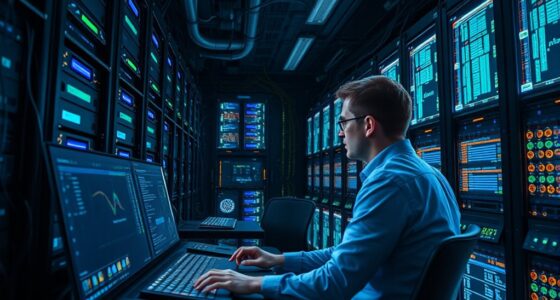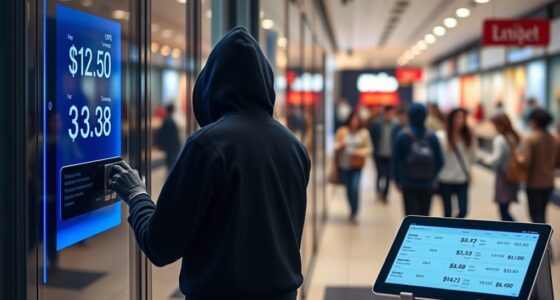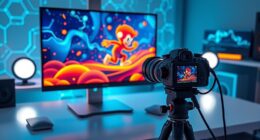We have witnessed the rise of artificial intelligence, and its impact on various sectors is undeniable.
But when it comes to media and entertainment, the game has truly changed. Generative AI has revolutionized the way visual effects are enhanced in films and television, streamlining production workflows like never before.
With AI-generated plotlines and realistic characters, storytelling reaches new heights while audience engagement skyrockets through personalized content.
Join us as we dive into the game-changing influence of generative AI on media and entertainment.
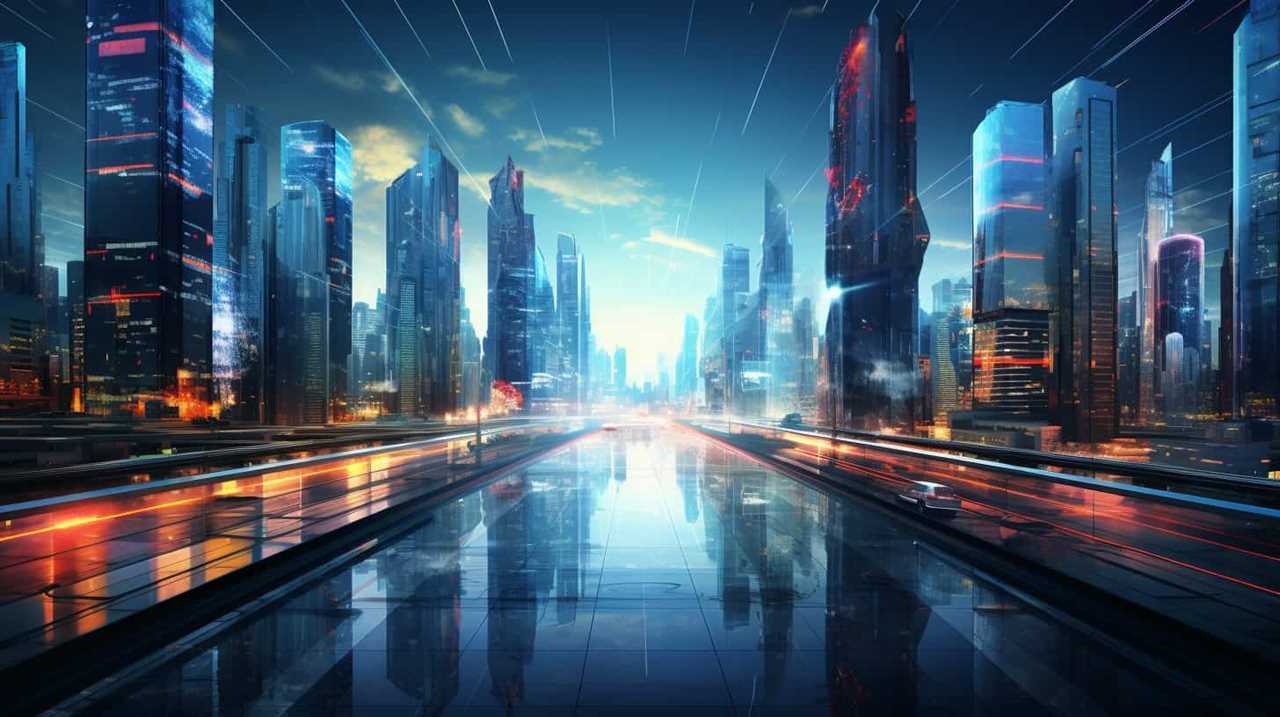
Key Takeaways
- Generative AI revolutionizes visual effects in film and television, enhancing overall quality and impact.
- AI streamlines production workflow by automating repetitive tasks, optimizing resource allocation, and facilitating collaboration.
- Generative AI creates realistic characters and environments, pushing the boundaries of virtual reality experiences.
- AI-generated plotlines revolutionize storytelling in media and entertainment, enhancing audience engagement and immersion.
Enhancing Visual Effects in Film and Television
In our industry, generative AI has revolutionized the way we enhance visual effects in film and television. It provides an unprecedented level of realism and creativity. Through the use of real-time rendering and virtual reality integration, generative AI algorithms have allowed us to create visually stunning and immersive experiences for our audience.
Real-time rendering enables us to generate and display images at an interactive rate, making it possible to see the final result of visual effects in real time. This has significantly reduced the time required for post-production, allowing us to iterate and refine our work more efficiently.
Additionally, virtual reality integration has opened up new possibilities for storytelling. It enables viewers to immerse themselves in virtual worlds and experience the visual effects firsthand.
With generative AI, we’ve been able to push the boundaries of what’s possible in visual effects, ultimately enhancing the overall quality and impact of our work.

As we delve into the next section about streamlining production workflow with AI, we must recognize the role that generative AI has played in transforming our industry.
Streamlining Production Workflow With AI
Generative AI has significantly streamlined our production workflow by automating repetitive tasks and enabling us to work more efficiently as a team. Here are four ways in which AI has revolutionized our production process:
-
Automating editing processes: AI algorithms can automatically analyze and edit video content, saving us countless hours of manual editing work. This allows us to focus on more creative and strategic aspects of production.
-
Optimizing resource allocation: AI algorithms can analyze data and predict resource requirements, helping us allocate our time, budget, and workforce more effectively. This ensures that we maximize productivity and minimize wastage.

-
Enhancing collaboration: AI-powered tools facilitate seamless collaboration among team members, allowing us to share and edit files in real-time. This eliminates the need for lengthy email exchanges and speeds up decision-making processes.
-
Increasing project efficiency: AI algorithms can analyze past project data to identify bottlenecks and inefficiencies, enabling us to streamline our workflows and deliver projects on time and within budget.
With our production workflow now optimized, let’s delve into how generative AI is transforming the creation of realistic characters and environments.
Creating Realistic Characters and Environments
With our production workflow now optimized, we can now explore the transformative power of generative AI in creating realistic characters and environments.
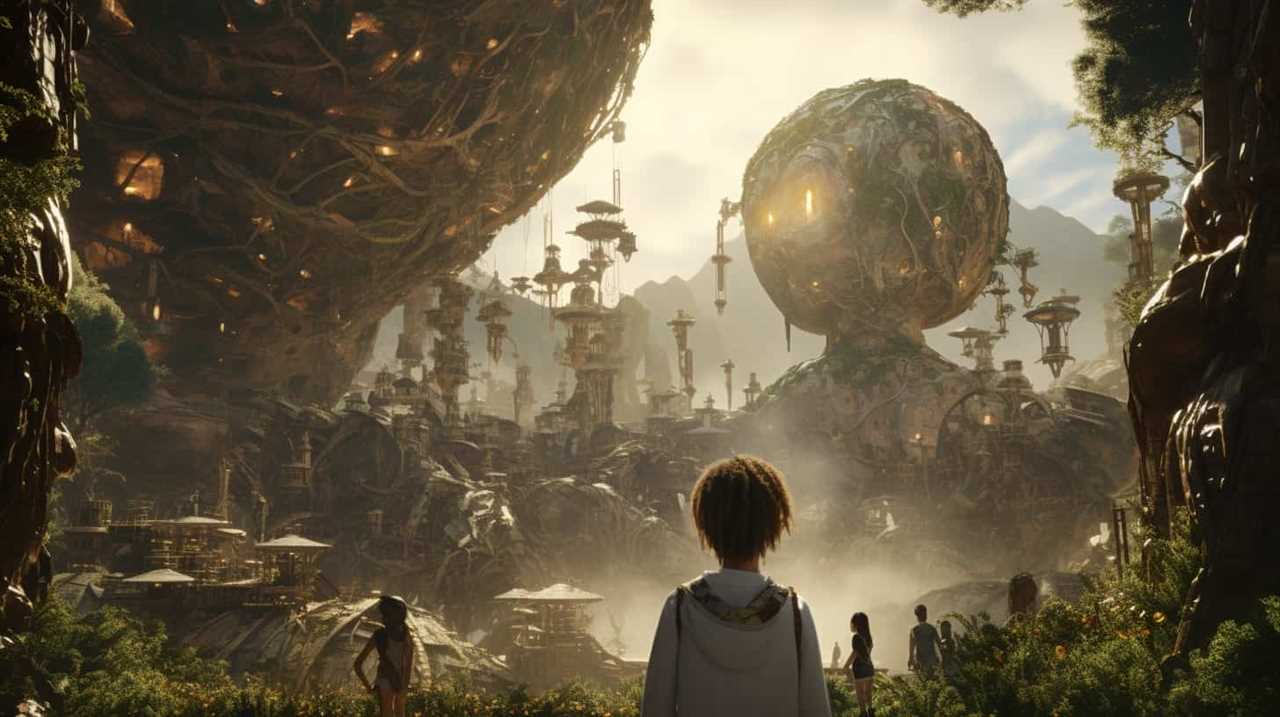
AI generated digital art has revolutionized the way we design and develop characters, giving us the ability to generate lifelike features and behaviors. By leveraging deep learning algorithms, AI can analyze vast amounts of data, such as facial expressions and body movements, to create characters that are indistinguishable from real humans.
Furthermore, AI’s ability to generate realistic environments has opened up new possibilities in the realm of virtual reality experiences. Through the use of generative AI, we can create immersive and believable worlds that transport users to entirely new dimensions.
The combination of AI and virtual reality has the potential to redefine the boundaries of entertainment, offering users unprecedented freedom and immersion in digital experiences.
Revolutionizing Storytelling With Ai-Generated Plotlines
Now, let’s explore how the revolutionary power of AI extends to revolutionizing storytelling through the creation of AI-generated plotlines. AI technology has the potential to transform the way stories are crafted and told in the media and entertainment industry. Here are four key aspects to consider:
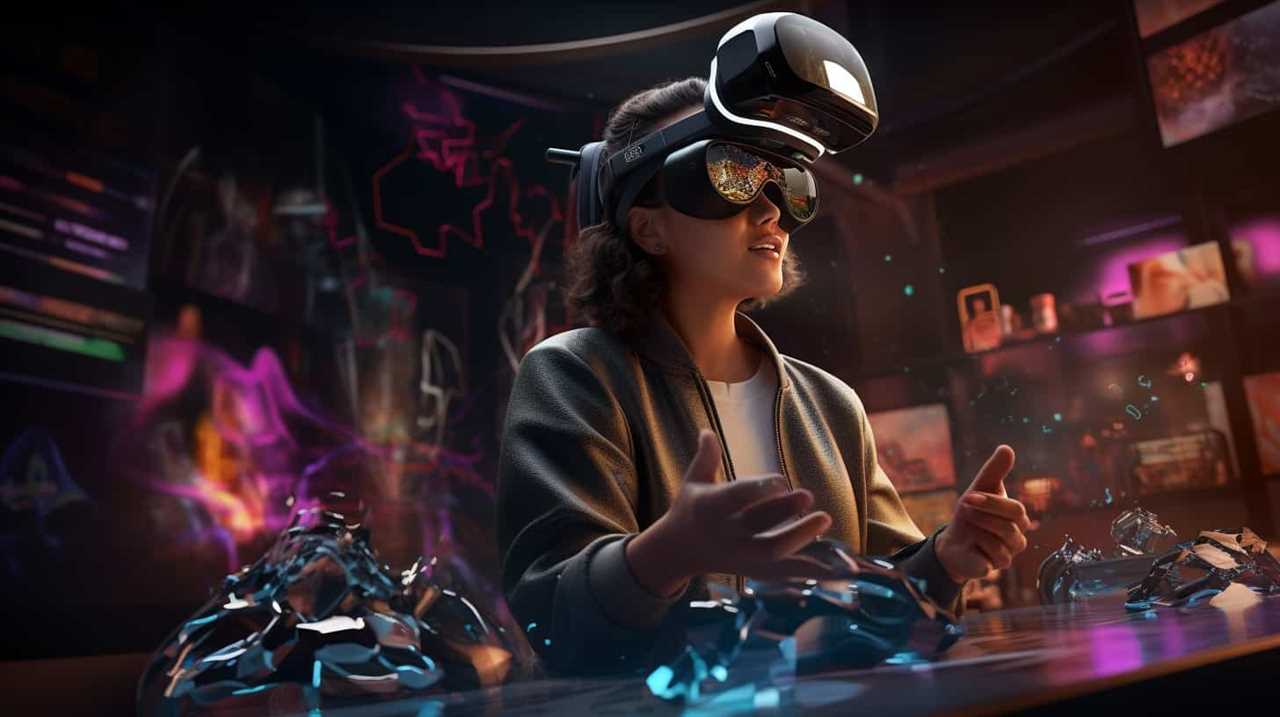
-
Ethical implications of AI-generated plotlines: As AI algorithms become more sophisticated, there are important ethical questions to address. Who should be responsible for the content produced by AI? How do we ensure that AI-generated stories don’t perpetuate harmful stereotypes or biases?
-
Balancing creativity and algorithmic storytelling: While AI can generate plotlines efficiently, it’s crucial to strike a balance between algorithmic storytelling and human creativity. The challenge lies in preserving the unique human touch and emotional depth that makes storytelling compelling.
-
Enhancing audience engagement: AI-generated plotlines have the potential to personalize and adapt narratives based on individual preferences, enhancing audience engagement and immersion in the story world.
-
Broadening storytelling possibilities: By leveraging AI, storytellers can explore new narrative structures, unconventional plotlines, and interactive storytelling experiences that were previously unimaginable.

As AI continues to advance, it’s essential to navigate the ethical implications and find ways to harness its power while preserving the artistry and human connection inherent in storytelling.
Improving Audience Engagement Through Personalized Content
AI-generated plotlines have the potential to significantly enhance audience engagement through the delivery of personalized content. By leveraging data-driven personalization and interactive storytelling, media and entertainment platforms can create more immersive and tailored experiences for their users. With AI, content creators can analyze vast amounts of audience data to gain insights into individual preferences, behavior patterns, and interests. This enables them to generate personalized content recommendations, recommendations for related media, and even adapt the plotlines of stories to match the viewer’s preferences. The table below highlights the benefits of incorporating data-driven personalization and interactive storytelling:
| Benefits of Data-Driven Personalization and Interactive Storytelling |
|---|
| Enhanced audience engagement |
| Increased viewer satisfaction |
| Improved retention rates |
| Enhanced user experience |
| Greater potential for monetization |
Frequently Asked Questions
How Does Generative AI Enhance Visual Effects in Film and Television?
Generative AI enhances visual effects in film and television by generating realistic and immersive visuals. AI-generated visuals in media and entertainment have revolutionized the industry, pushing the boundaries of creativity and delivering unparalleled visual experiences.
What Are Some Examples of AI Tools That Can Streamline Production Workflow in the Media and EntertAInment Industry?
AI driven automation and AI powered editing are revolutionizing the media and entertainment industry. These tools streamline production workflow, allowing us to create content faster and more efficiently. It’s incredible how technology is shaping our creative process.
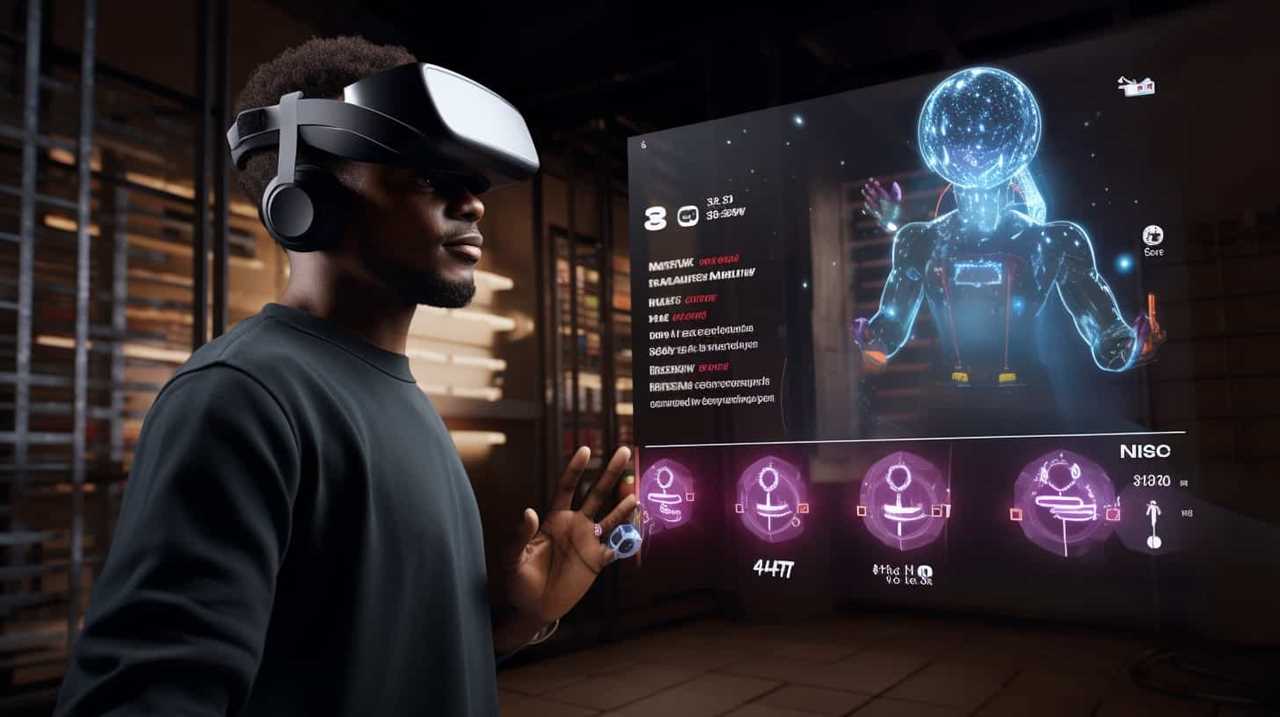
How Does Generative AI Contribute to Creating Realistic Characters and Environments in Movies and Video Games?
Generative AI revolutionizes media and entertainment by creating AI-generated realistic characters and immersive environments. It elevates the industry, allowing us to unleash our creativity and deliver unparalleled experiences to our audience.
Can You Provide Some Examples of How Ai-Generated Plotlines Have Revolutionized Storytelling in Different Forms of Media?
AI-generated plotlines have revolutionized storytelling in literature, creating unexpected twists and intricate narratives. In the music industry, AI has composed unique melodies and harmonies, pushing the boundaries of creativity.
How Does Personalized Content Generated Through AI Improve Audience Engagement in the Media and EntertAInment Industry?
Personalized recommendations enhance audience engagement in media and entertainment. AI-generated music, for example, tailors the listening experience to individual preferences. This level of customization fosters a sense of freedom and empowers users to explore content that resonates with their unique tastes.
Conclusion
In conclusion, the game-changing influence of generative AI in media and entertainment is undeniable. It has revolutionized visual effects, streamlining production workflow, and creating realistic characters and environments.

But it doesn’t stop there. AI-generated plotlines are reshaping storytelling, while personalized content enhances audience engagement. The use of AI in these fields brings a level of precision and efficiency that was previously unimaginable.
As we continue to explore the possibilities of generative AI, the future of media and entertainment looks promising and exciting.





